Minimalist Aquascaping: 5 Steps to Create Living Art in Your Fish Tank (Easy Guide for Beginners)
Minimalist Aquascaping: 5 Steps to Create Living Art in Your Fish Tank (Easy Guide for Beginners)
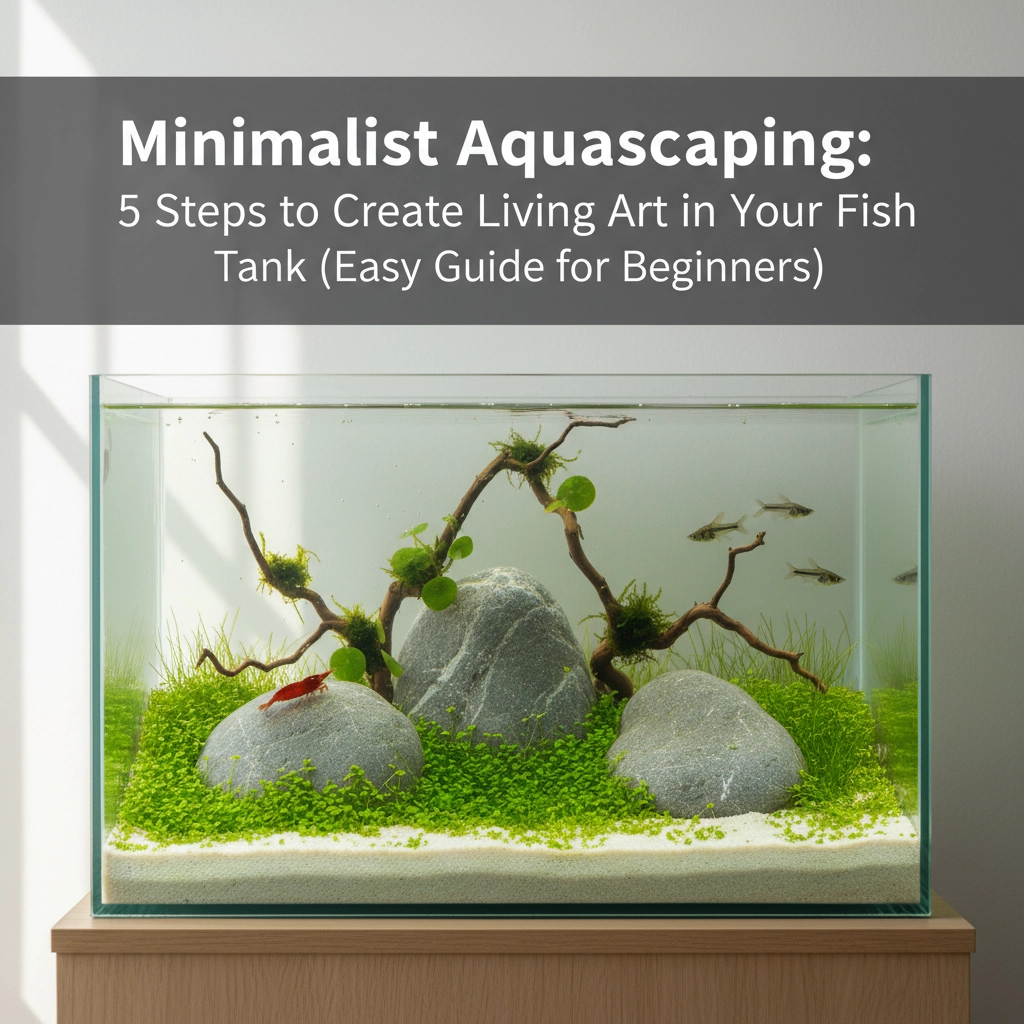
Welcome, aspiring aquatic artists! Whether you're a seasoned veteran looking to dive into a new style or a newcomer ready to dip your toes into the mesmerizing world of aquascaping, minimalist design offers the perfect gateway to creating your own underwater masterpiece. Far from being "boring" or "empty," minimalist aquascaping is actually one of the most sophisticated approaches to tank design: and surprisingly, it's often easier for beginners to master than densely planted setups.
Think of minimalist aquascaping as the art of saying more with less. Instead of cramming every inch of your tank with plants, rocks, and decorations, you'll learn to create captivating focal points, embrace negative space, and let each carefully chosen element shine like a jewel in your aquatic oasis. This approach not only creates stunning visual impact but also makes maintenance a breeze, allowing you to spend more time enjoying your creation and less time wrestling with overgrown plants.
Ready to transform your tank into a work of living art? Let's dive into the five essential steps that will have you creating museum-quality aquascapes in no time.
Step 1: Master the Art of Planning Your Underwater Canvas
Before you even think about adding a single pebble to your tank, grab a pencil and paper: this step is absolutely crucial for minimalist success. The difference between a breathtaking aquascape and a cluttered mess often comes down to one thing: intentional planning.
Start by sketching your tank from multiple angles. Visualize it as a three-dimensional space, not just a flat picture frame. The most captivating minimalist aquascapes follow the Rule of Thirds, a time-tested principle borrowed from photography and art. Imagine dividing your tank into a tic-tac-toe grid, and place your main focal point where those lines intersect: never dead center.
Your focal point should be the star of your show. This could be a dramatic piece of driftwood with sweeping curves, an imposing rock formation, or even a carefully positioned group of plants. The key is choosing ONE primary element that will draw the eye and serve as the anchor for your entire composition.
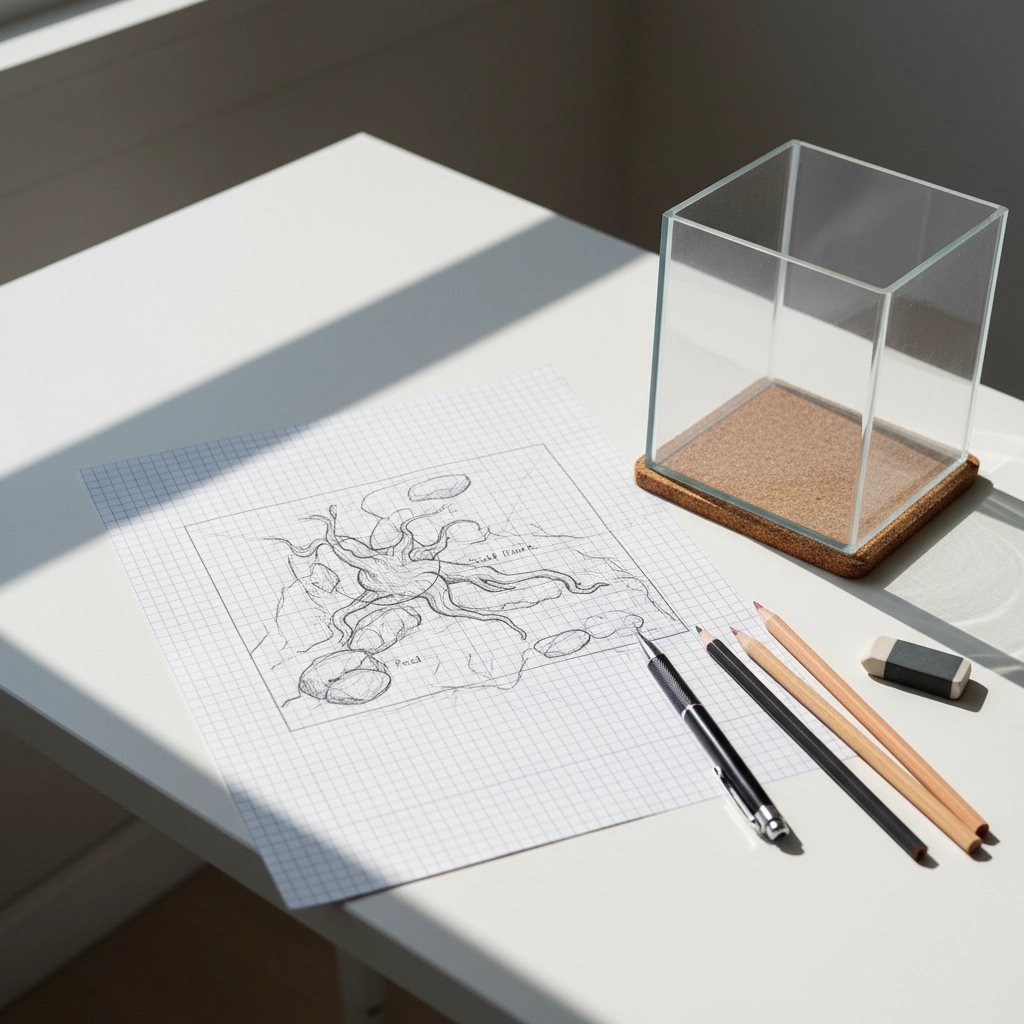
As you sketch, think about the story you want your aquascape to tell. Are you creating a serene mountain lake? A peaceful forest stream? A dramatic cliff face? Having this narrative in mind will guide every decision you make moving forward, ensuring your finished aquascape feels cohesive and purposeful rather than random.
Step 2: Choose Your Hardscape Like a Sculptor Selects Marble
Your hardscape: the rocks, wood, and other non-living elements: forms the permanent backbone of your minimalist masterpiece. In minimalist design, each piece needs to earn its place through exceptional quality and visual impact.
For rocks, consider these stunning options that work beautifully in minimalist setups:
- Seiryu stone: Offers dramatic grey coloration with white veining
- Ohko Dragon stone: Creates striking, textured formations with warm tones
- Black lava rock: Provides bold contrast and interesting surface textures
When selecting driftwood, look for pieces with clean, flowing lines that complement your tank's proportions. Malaysian driftwood and spider wood are excellent choices for their naturally sculptural qualities.
Here's a pro tip that separates amateur aquascapers from the pros: use an odd number of elements in your hardscape arrangement. Three rocks of varying sizes, for instance, creates more visual interest than two or four. Position your largest, most striking piece as the primary focal point, then use smaller elements to create visual balance without competing for attention.
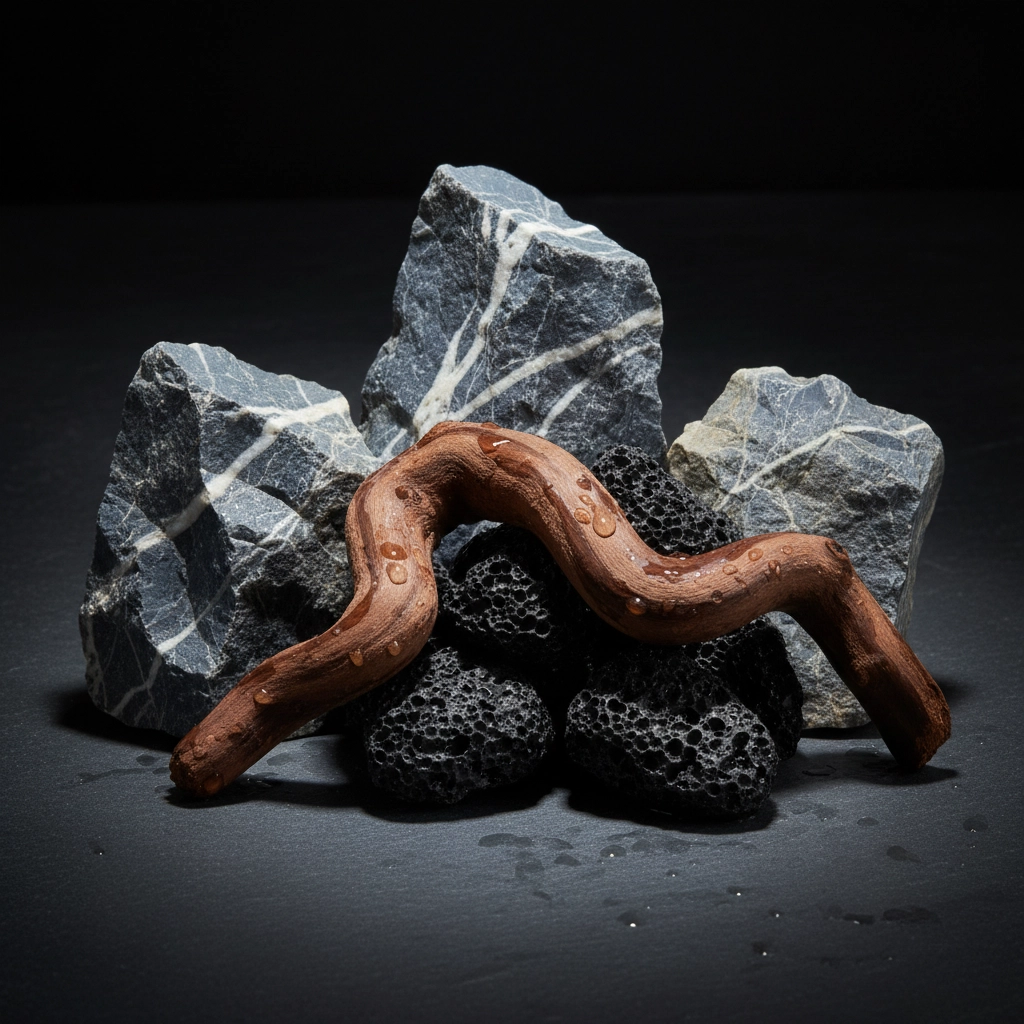
Remember, in minimalist aquascaping, you're not trying to fill space: you're creating intentional negative space that allows your chosen elements to breathe and command attention. Think quality over quantity, always.
Step 3: Plant Strategically, Not Randomly
Here's where many beginners get tripped up: they think minimalist means "barely any plants." Actually, minimalist aquascaping is about strategic plant placement that enhances your hardscape rather than overwhelming it.
Your plant selection should support your aquascape's story while maintaining clean, uncluttered lines. Consider these minimalist-friendly categories:
Background plants provide height and framing without stealing focus. Fast-growing stem plants like Rotala or Ludwigia work beautifully when trimmed into clean, geometric shapes that complement your hardscape.
Carpet plants can create stunning negative space effects. A well-maintained carpet of Monte Carlo or Glossostigma can look like an underwater lawn, providing subtle texture while keeping the focus on your main elements.
Accent plants should be used sparingly: think of them as punctuation marks in your aquatic sentence. A single, perfectly placed Anubias or a small cluster of Cryptocoryne can add just enough organic softness to balance harder hardscape elements.
The magic happens in the spaces between plants. Don't be afraid of bare substrate or open water: these "empty" areas are actually essential design elements that give your eyes places to rest and make your focal points pop even more dramatically.
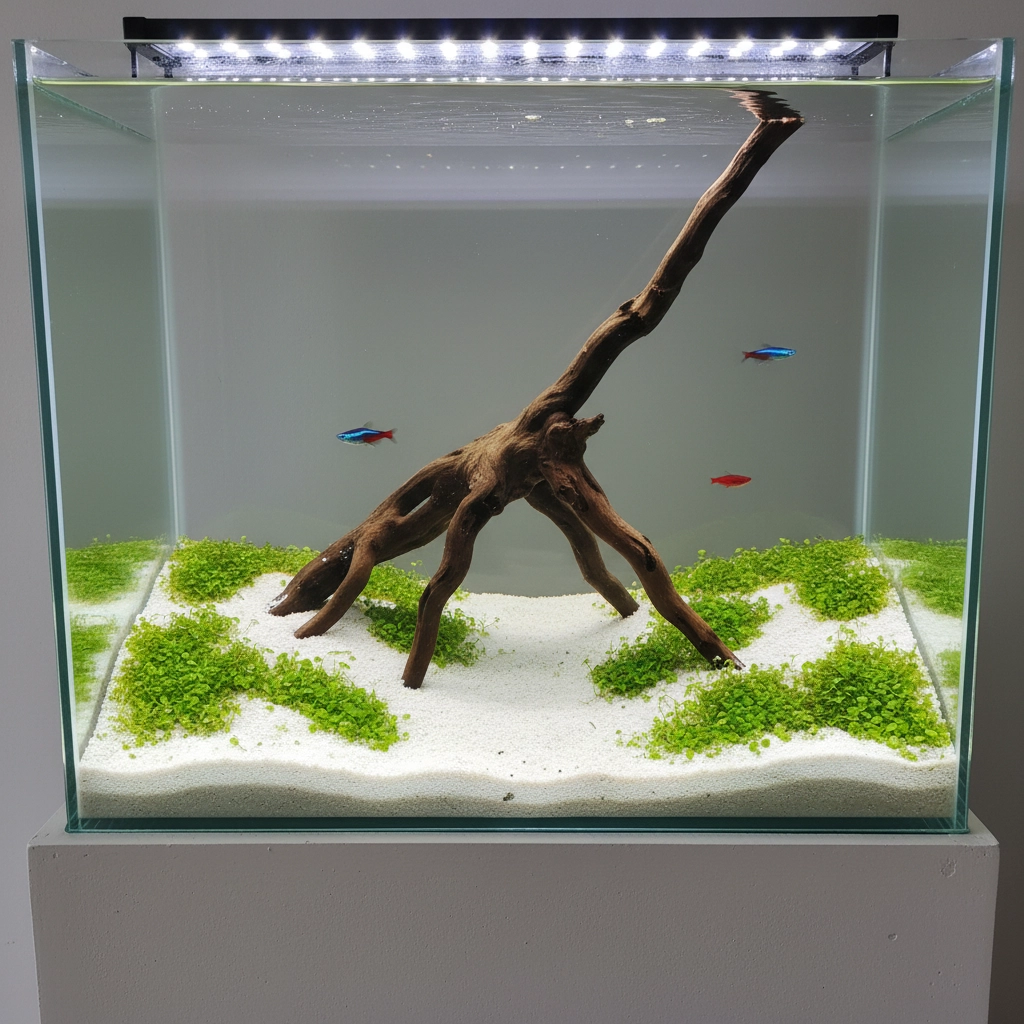
Step 4: Create Depth Through Layered Composition
One of the most thrilling aspects of aquascaping is creating the illusion of vast underwater landscapes within the confines of your glass box. The secret lies in understanding how to layer elements to create depth and perspective.
Visualize your tank as having three distinct zones:
- Foreground: Your viewing area, kept relatively open with perhaps some low carpet plants or small accent stones
- Midground: Where your primary focal point lives, creating the main visual story
- Background: Taller elements that provide context and frame your composition
By varying the heights, textures, and positions of elements across these zones, you'll create a sense of dimensionality that draws viewers deep into your aquatic world. A small piece of driftwood in the foreground can appear massive when viewed in perspective with larger elements positioned further back.
Pay attention to sightlines: the invisible paths your eye follows through the aquascape. In the best minimalist designs, these sightlines flow naturally from one element to the next, creating a visual journey that keeps viewers engaged without overwhelming them.
Consider how different viewing angles will impact your design. Your aquascape should look captivating from multiple perspectives, not just straight-on. This three-dimensional thinking is what separates good aquascapes from truly exceptional ones.
Step 5: Maintain the Vision Through Thoughtful Care
Creating your minimalist masterpiece is just the beginning: maintaining its clean, intentional aesthetic requires ongoing attention and restraint. This is where many aquascapers struggle, gradually adding elements until their minimalist vision becomes cluttered chaos.
Resist the urge to fill every space. That patch of bare substrate isn't "empty": it's negative space that makes your focal points more powerful. Those areas of open water aren't "boring": they're breathing room that prevents visual overwhelm.
Establish a regular trimming routine that maintains your plants' intended shapes and sizes. In minimalist aquascaping, precision trimming is an art form. Your background plants should maintain clean, geometric lines rather than growing into wild, organic shapes that compete with your hardscape.
Keep your lighting schedule consistent: typically 6-8 hours daily: to support healthy plant growth without encouraging excessive algae that can mar your clean aesthetic. A minimalist aquascape with algae problems quickly loses its serene, gallery-like quality.

Most importantly, resist the collector's impulse to keep adding new plants, rocks, or decorations. Every addition should serve a specific purpose in your overall design vision. If you can't articulate why a new element makes your aquascape better, leave it out.
Your minimalist aquascape should evolve slowly and deliberately, with each change enhancing rather than complicating your original vision. This restraint is what transforms a simple fish tank into a work of living art that brings years of joy and tranquility to your space.
The beauty of minimalist aquascaping lies not in what you include, but in what you choose to leave out. By following these five steps, you'll create an underwater sanctuary that proves sometimes the most profound statements come through whispers, not shouts.
Ready to start your minimalist aquascaping journey? We'd love to see your creations! Follow us on social media for daily inspiration, connect with our community of fellow aquatic artists, and don't hesitate to reach out with any questions about your aquascaping adventure. Share photos of your minimalist masterpieces with us( you might just be featured in our community spotlight!)
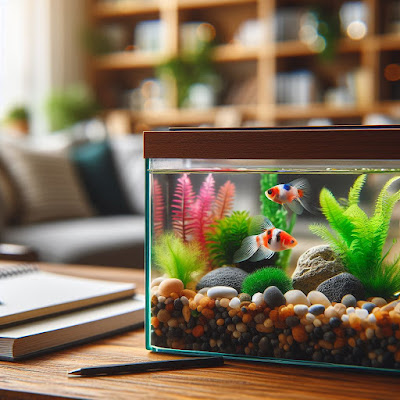






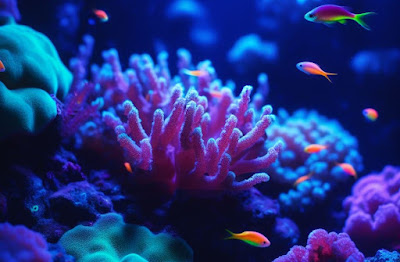
.png)
